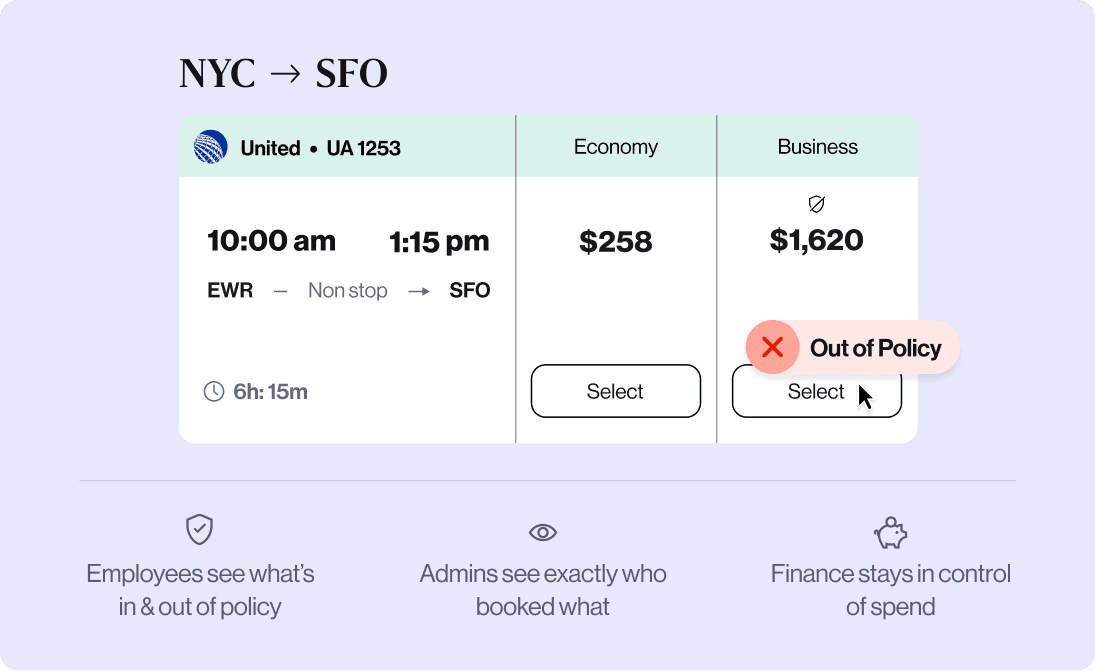How to Manage Business Travel Processes After Surpassing 100 Employees
The Navan Team

Surpassing 100 employees is a significant milestone for any organization. This achievement marks a pivotal moment in a company's growth trajectory, bringing with it a host of new opportunities and challenges. Among these challenges is managing business travel efficiently and cost-effectively, which becomes increasingly complex as your workforce expands.
Gone are the days when a simple spreadsheet or a handful of travel agency contacts could suffice for coordinating your company's travel needs. With a larger team spread across various departments, possibly multiple locations, and an increasing frequency of business trips, the need for a more sophisticated, cost-effective approach to travel management becomes evident.
This guide will explore effective strategies to streamline your business travel management process. Let's dive in and discover how to transform your business travel management into a strategic asset for your growing company, starting with key strategies for efficient business travel management:
1. Leverage a Comprehensive Travel Management Platform
A robust travel management platform is a necessity today as travel expenses are consistently one of the top operational expenses for companies. Navan, a business travel platform designed to streamline the entire travel management process, is one standout solution in this space. Here's how a platform like Navan can revolutionize your approach to business travel:
Implementing a comprehensive travel management platform like Navan can significantly reduce the administrative burden on your HR and finance teams while providing a better experience for your traveling employees. It's an investment that quickly pays off in terms of time saved, improved policy compliance, and better visibility into travel spend.
Benefits of using a travel management platform
- Employees see what’s in and out of policy
- Admins see exactly who booked what
- Finance saves on travel
2. Develop a Clear and Comprehensive Travel Policy

As your company grows, having a well-defined travel policy becomes increasingly crucial. A good travel policy serves as a guidebook for employees, setting clear expectations and guidelines for business travel. An effective travel policy:
Once you've developed your policy, the next crucial step is effective communication:
Remember, a travel policy is a living document. Your policy should adapt as your business evolves and travel trends change. Schedule regular reviews — at least annually — to ensure your policy remains relevant and effective.
When you onboard your company to Navan, you can add custom policies or get started quickly with our smart suggestions. Because employees book travel in Navan, they see exactly what they can and can’t book for every travel search.
Navan also lets you create dynamic travel policies that automatically adjust based on fair market value, which means factors like seasonality are taken into account.
3. Implement an Approval Process

For companies with more than 100 employees, implementing an approval process for business travel can help maintain control over travel spend and ensure trips align with business objectives.
Here's how to set up an efficient approval system:
By implementing a well-designed approval process, you can ensure that all business travel aligns with company objectives and budgets while providing employees the flexibility they need to do their jobs effectively.
With Navan, you can automate the approvals process based on whether your travelers book in or out of policy. This makes it easier for employees to book travel to get business done and close the best travel rate instead of waiting for their manager or finance to approve it manually and find that the rate expired.
4. Prioritize Travel Safety and Support
As your employee base grows and business travel increases, it takes even more diligence to prioritize the safety and well-being of travelers.
Here's how to build a robust travel safety and support program:
Remember, demonstrating a strong commitment to traveler safety not only protects your employees but also boosts morale and can be a powerful tool for employee retention and recruitment.
5. Leverage Data for Continuous Improvement
Making data-driven decisions about your travel program can lead to significant improvements and cost savings. Here's how to effectively use travel data:
• Total travel spend
• Average trip cost
• Policy compliance rate
• Traveler satisfaction scores
• Booking lead time
• Top destinations and routes
• Preferred vendor utilization rates
• Carbon footprint of travel
Navan’s dashboards give you a high-level overview of your company’s travel trends and allow you to dive deeper with filters. You can also build custom reports and set up a sending schedule so stakeholders get access to the right data in a timely manner.
6. Foster a Culture of Responsible Travel
Creating a culture of responsible travel goes beyond simply having a travel policy — it involves instilling a sense of ownership and accountability in your employees when it comes to business travel. Here's how to cultivate this culture:
Remember, effective travel management is an ongoing process. Regularly review and refine your approaches, stay attuned to emerging trends in business travel, and always keep the needs of your travelers at the forefront of your decisions. With these strategies in place, you'll be well-equipped to manage business travel effectively, no matter how much your company grows.
This content is for informational purposes only. It doesn't necessarily reflect the views of Navan and should not be construed as legal, tax, benefits, financial, accounting, or other advice. If you need specific advice for your business, please consult with an expert, as rules and regulations change regularly.
More content you might like
Take Travel and Expense Further with Navan
Move faster, stay compliant, and save smarter.